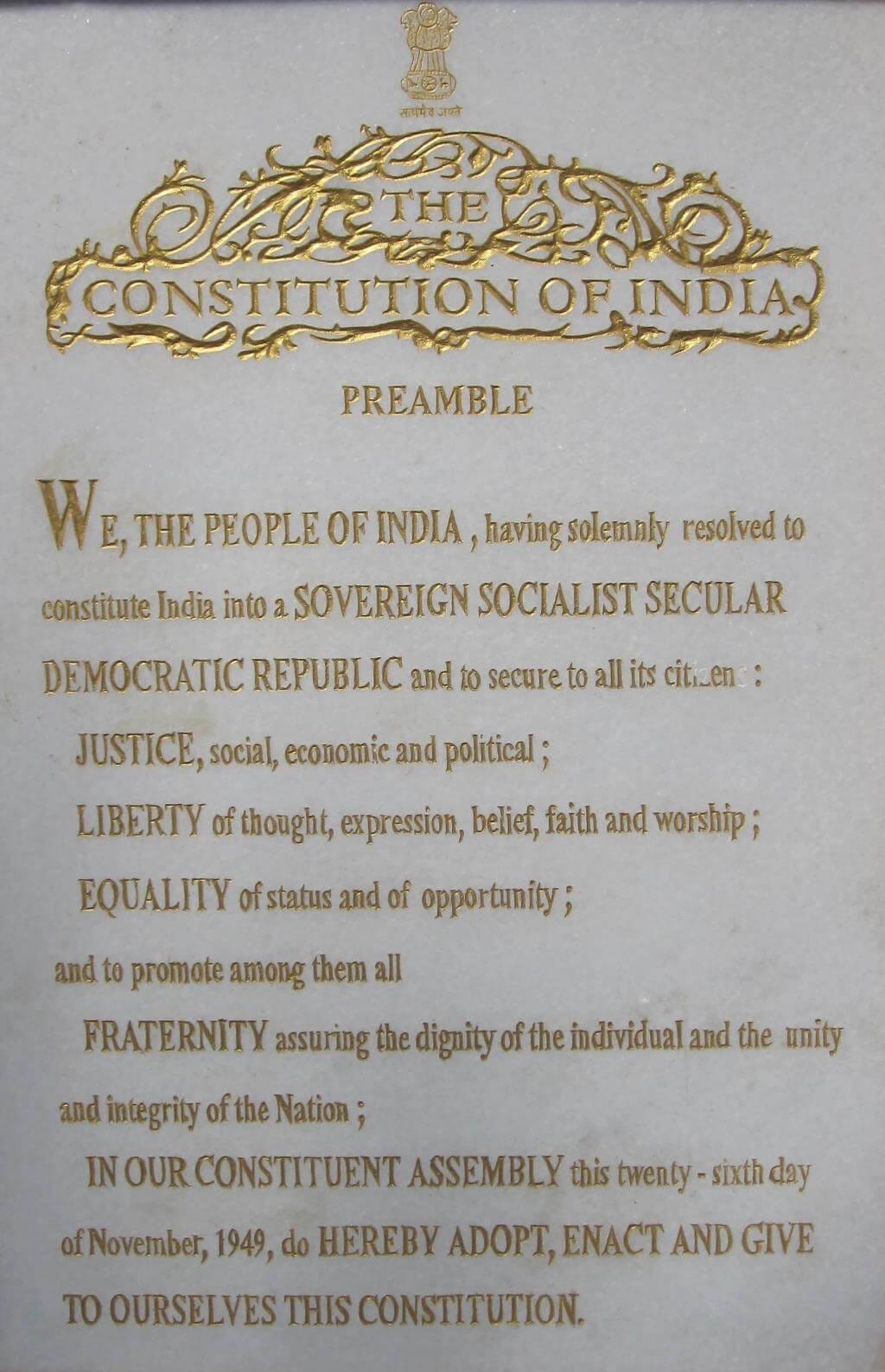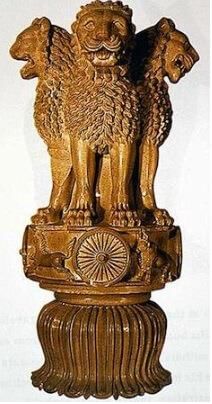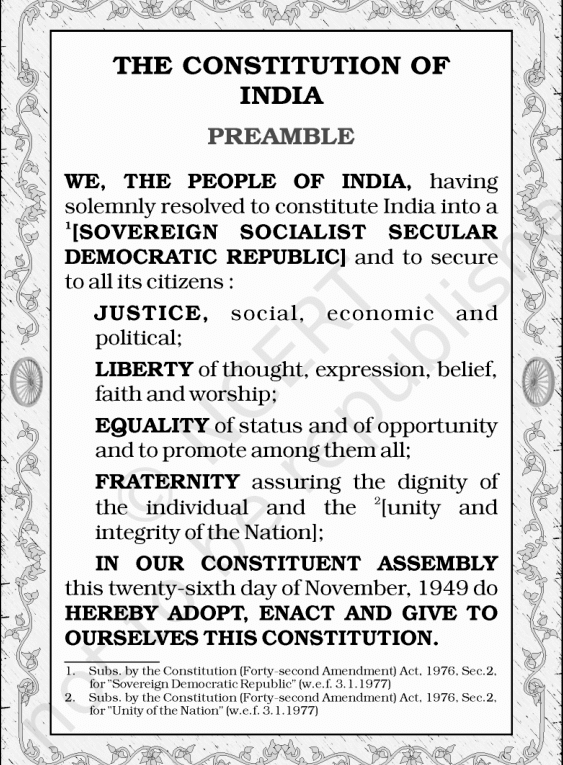Revision Notes: Salient Features of the Indian Constitution | Indian Polity for UPSC CSE PDF Download
| Table of contents |

|
| Salient Features of The Indian Constitution |

|
| Fundamental Rights |

|
| Directive Principles of State Policy |

|
| Universal Adult Suffrage |

|
| Independent Judiciary |

|
| Secular State |

|
| Fundamental Duties |

|
Salient Features of The Indian Constitution
The framers of the Indian Constitution sought to incorporate the beneficial provisions of various foreign Constitutions to avoid potential defects and loopholes in its future implementation.

Thus, they framed the chapters on:
Fundamental Rights on the model of American Constitution;
Directive Principles on the model of Constitution of Ireland;
Emergency provisions on the model of German Reich and Govt. of India Act, 1935;
The parliamentary system of Government has been modelled on the British system.
The Indian Constitution lays down the structure not only of the Central government but also of the States. In contrast, the US Constitution leaves the States to draw up their own Constitutions.
The vastness of the country and peculiar problems relating to language have added to the bulk of the Constitution. It was felt that the smooth working of an infant democracy might be jeopardized unless the Constitution mentioned in detail things which were left to ordinary legislation in other Constitutions. That is why our Constitution contains detailed provisions about the organisation of judiciary, the services, elections, and the like.
The Indian Constitution is the lengthiest and the most detailed of all the written constitutions of the world.Currently, it consists of 448 Articles ,Articles divided into 25 parts and 12 Schedules.
Parliamentary Form of Government National emblem of India
National emblem of India
The Constitution of India establishes a parliamentary form of government at both the Centre and the States. While the Constitution-makers drew inspiration from the British model, they incorporated modifications to suit India's federal structure and unique needs.
The essence of the parliamentary system is its responsibility to the legislature. The President is the Constitutional head of the State, while real executive power is vested in the Council of Ministers, headed by the Prime Minister. At the Centre, the Council of Ministers is collectively responsible to the Lok Sabha (lower house). In the States, the Governor serves as the constitutional head, while the Council of Ministers, headed by the Chief Minister, is responsible to the Legislative Assembly.
The members of the Lok Sabha are elected directly by the people. At the state level, the members of the Legislative Assembly are also elected directly by the people, while members of the Legislative Council (in states with bicameral legislatures) are elected indirectly.
In contrast, the US Constitution establishes a Presidential system of Government based on the principle of separation of powers. The President is the real executive, elected for a fixed term through an Electoral College system. He is not responsible to the Congress, and the members of his cabinet are not members of the legislature. They are appointed by the President and are directly responsible to him.
Unique Blend of Rigidity and Flexibility
A rigid Constitution is one that requires a special method of amendment for any of its provisions, while in a flexible Constitution, the provisions can be amended by ordinary legislative processes. Written Constitutions are often rigid but not necessarily so.
The Indian Constitution, though written, is sufficiently flexible. However, a few provisions of the Constitution, especially those affecting the federal structure, require the consent of half of the state legislatures. The rest of the provisions can be amended by a special majority of Parliament as prescribed under Article 368.
Fundamental Rights
Inspired by the principles of Natural Law, the need to enable the fullest development of the human personality, and the protection of human dignity and worth, our Constitution makers incorporated a complete code of human rights in Part III of the Constitution (Articles 12-35).
The State cannot make a law that takes away or abridges any of the rights guaranteed in Part III of the Constitution, except under reasonable restrictions provided within the Constitution. If such a law is passed, it can be declared unconstitutional by the courts. The Supreme Court is empowered to issue writs such as Habeas Corpus, Mandamus, Prohibition, Certiorari, and Quo Warranto when these rights are violated.
However, the Fundamental Rights are not absolute. They are subject to reasonable restrictions to balance individual rights with the protection of social and national interests
Directive Principles of State Policy
The Directive Principles of State Policy, contained in Part IV (Articles 36-51), outline the aims and objectives to be pursued by the state in the governance of the country. These principles act as a guide for creating laws and policies that promote social, economic, and political justice.
Unlike Fundamental Rights, the Directive Principles are non-justiciable, meaning that if the state fails to implement any provision of Part IV, no legal action can be brought against it in a court of law. However, they are fundamental to the governance of the country and serve as a framework for achieving the ideals of a Welfare State.
The realization of the Welfare State, as envisaged in Part IV of the Constitution, depends on the state implementing these principles with a genuine sense of moral duty and commitment. Although they are not legally enforceable, the Directive Principles have influenced policy-making and judicial interpretation, especially in ensuring social and economic justice.
 A Federation with Unitary Features
A Federation with Unitary FeaturesThe most remarkable feature of the Indian Constitution is that, while being a Federal Constitution, it acquires a unitary character under certain conditions. During the proclamation of emergency, the normal distribution of powers between the Centre and the States undergoes a vital change. The Union Parliament is empowered to legislate on any subject in the State List (Article 250). The Central Government can also direct states on how to exercise their executive powers (Article 353). Additionally, the financial arrangements between the Centre and States can be altered (Article 354). Thus, during an emergency, the Constitution assumes a unitary character.
Universal Adult Suffrage
The old system of communal electorates has been abolished, and the uniform adult suffrage system has been adopted. Under the Indian Constitution, every citizen aged 18 years or above (reduced from 21 years by the 61st Amendment Act, 1989) has the right to vote. This adoption of universal adult suffrage (Article 326), without discrimination based on sex, property, taxation, or similar qualifications, is a bold experiment considering India's vast population and historically high illiteracy rates.Independent Judiciary
A mere enumeration of Fundamental Rights without proper safeguards serves little purpose. The Indian Constitution establishes an independent and impartial judiciary with the power of judicial review. It is the custodian of citizens' rights and plays a significant role in determining the limits of power between the Centre and the States. Fundamental Rights are enforced through remedies under Article 32 and Article 226.
Secular State
The Constitution establishes India as a secular state, where the state adopts an attitude of equality toward all religious communities. Articles 25 to 28 give shape to this concept by guaranteeing every person the freedom of conscience and the right to profess, practice, and propagate religion, subject to public order, morality, and health. Religious freedom cannot be used for economic exploitation, and the right to own, acquire, and administer property is regulated under Article 300A.
Fundamental Duties
Any act of disrespect toward the Indian National Flag is illegal under The Prevention of Insults to National Honour Act, 1971.
In line with the recommendations of the Swaran Singh Committee, the 42nd Constitutional Amendment Act, 1976, introduced a Code of ten Fundamental Duties for citizens. Later, the 86th Constitutional Amendment Act, 2002, added an eleventh duty, making the total eleven under Article 51A.
Although Fundamental Duties are non-justiciable, the judiciary may consider them while determining the reasonableness of laws under Articles 14 and 19. They also serve as a moral guide against antisocial activities like burning the Constitution or destroying public property.
Facts to be Remembered
The presiding officer of Panchayat is called by a variety of names in different states such as
- Pardhan— Assam, Kerala and Tamil Nadu.
- Sarpanch — Andhra Pradesh, Gujarat, Jammu-Kashmir, Madhya Pradesh, Maharashtra, Orissa, Punjab and Rajasthan.
- Mukhiya — Bihar and Orissa.
- Sabhapati— West Bengal.
- Pradhan — Uttar Pradesh The tenure of panchayat, again, varies from state to state at five years (Article 243E).
- Three years : Andhra Pradesh, Orissa and Rajasthan.
- Four years : Assam, Gujarat, Jammu-Kashmir, Maharashtra and West Bengal.
- Five years : Kerala, Madhya Pradesh, Tamil Nadu, Karnataka, Haryana, Punjab and Uttar Pradesh.
- In Bihar three classes of panchayats are seen and the term of office was fixed for five years, irrespective of state or category. They are Prathama Varga gram panchayat with a 5-year term, Dvitiya Varga gram panchayat with four years of office and Tritiya Varga gram panchayat with a three-year term.
Panchayat Samiti - The panchayat samiti is the intermediate tier in the panchayati raj system of rural local government. It is known by various names in the states of India like :
- Panchayat Samiti — Andhra Pradesh, Bihar, Maharashtra, Orissa and Rajasthan
- Kshetra Samiti — Uttar Pradesh
- Anchalik Panchayat — Assam
- Anchalik Parishad — West Bengal
- Taluk Panchayat — Gujarat
- Japapada Panchayat — Madhya Pradesh
- Taluk Development Board — Karnataka
- Panchayat Union Council — Tamil Nadu The term of office was fixed for 5 years
|
150 videos|780 docs|202 tests
|
FAQs on Revision Notes: Salient Features of the Indian Constitution - Indian Polity for UPSC CSE
| 1. What are the Fundamental Rights guaranteed by the Indian Constitution? |  |
| 2. What are the Directive Principles of State Policy in the Indian Constitution? |  |
| 3. What does Universal Adult Suffrage mean in the context of the Indian Constitution? |  |
| 4. How does the Indian Constitution ensure an Independent Judiciary? |  |
| 5. What are the Fundamental Duties of Indian citizens as per the Constitution? |  |
















